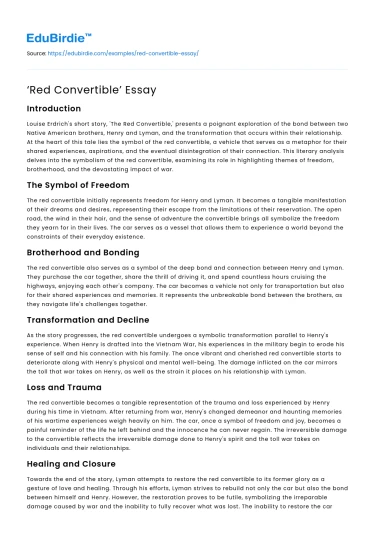Introduction
Louise Erdrich's short story, 'The Red Convertible,' presents a poignant exploration of the bond between two Native American brothers, Henry and Lyman, and the transformation that occurs within their relationship. At the heart of this tale lies the symbol of the red convertible, a vehicle that serves as a metaphor for their shared experiences, aspirations, and the eventual disintegration of their connection. This literary analysis delves into the symbolism of the red convertible, examining its role in highlighting themes of freedom, brotherhood, and the devastating impact of war.
The Symbol of Freedom
The red convertible initially represents freedom for Henry and Lyman. It becomes a tangible manifestation of their dreams and desires, representing their escape from the limitations of their reservation. The open road, the wind in their hair, and the sense of adventure the convertible brings all symbolize the freedom they yearn for in their lives. The car serves as a vessel that allows them to experience a world beyond the constraints of their everyday existence.
Save your time!
We can take care of your essay
- Proper editing and formatting
- Free revision, title page, and bibliography
- Flexible prices and money-back guarantee
Brotherhood and Bonding
The red convertible also serves as a symbol of the deep bond and connection between Henry and Lyman. They purchase the car together, share the thrill of driving it, and spend countless hours cruising the highways, enjoying each other's company. The car becomes a vehicle not only for transportation but also for their shared experiences and memories. It represents the unbreakable bond between the brothers, as they navigate life's challenges together.
Transformation and Decline
As the story progresses, the red convertible undergoes a symbolic transformation parallel to Henry's experience. When Henry is drafted into the Vietnam War, his experiences in the military begin to erode his sense of self and his connection with his family. The once vibrant and cherished red convertible starts to deteriorate along with Henry's physical and mental well-being. The damage inflicted on the car mirrors the toll that war takes on Henry, as well as the strain it places on his relationship with Lyman.
Loss and Trauma
The red convertible becomes a tangible representation of the trauma and loss experienced by Henry during his time in Vietnam. After returning from war, Henry's changed demeanor and haunting memories of his wartime experiences weigh heavily on him. The car, once a symbol of freedom and joy, becomes a painful reminder of the life he left behind and the innocence he can never regain. The irreversible damage to the convertible reflects the irreversible damage done to Henry's spirit and the toll war takes on individuals and their relationships.
Healing and Closure
Towards the end of the story, Lyman attempts to restore the red convertible to its former glory as a gesture of love and healing. Through his efforts, Lyman strives to rebuild not only the car but also the bond between himself and Henry. However, the restoration proves to be futile, symbolizing the irreparable damage caused by war and the inability to fully recover what was lost. The inability to restore the car serves as a metaphor for the inability to fully heal the wounds inflicted by trauma.
Conclusion
Louise Erdrich's 'The Red Convertible' masterfully employs the symbol of the red convertible to explore themes of freedom, brotherhood, and the devastating impact of war. The car, initially representing freedom and joy, transforms alongside Henry's experiences, ultimately reflecting the irreparable damage inflicted by war on individuals and their relationships. Through the symbol of the red convertible, Erdrich highlights the profound effects of trauma, loss, and the unbreakable bonds of brotherhood. The story serves as a reminder of the lasting impact of war on individuals and the challenges they face in finding healing and closure.






 Stuck on your essay?
Stuck on your essay?

